Tom's Guide Verdict
The 2020 version of the 27-inch iMac looks the same, but has beefier specs, a better webcam and a great screen.
Pros
- +
Great display
- +
Rich-sounding speakers
- +
Powerful graphics and processor
Cons
- -
Thick bezels
- -
Ports all on back
Why you can trust Tom's Guide
The Apple iMac 27-inch (2020) couldn’t have come at a better time. Even as late as December, no one would have predicted that having a great webcam would be a necessity for all those Zoom calls we would be conducting in t-shirts and bathrobes. But here we are.
While the Apple iMac 27-inch looks identical to several previous generations, the insides have been upgraded with 10th generation Intel processors, AMD Radeon Pro 5000 series graphics, and perhaps most importantly, a 1080p webcam that will let your coworkers see your quarantine hair in all its glory.
But as we discovered during our Apple iMac 27-inch review, there are even more great features, such as the optional nano-texture glass and enhanced speakers, that make it one of the best all-in-one computers you can buy despite its high price. In fact, it's so good that it won a recommendation for best all-in-one PC in our Tom's Guide Awards 2021.
Editor's Note: On March 8th, 2022, Apple killed the 27-inch iMac.
Apple iMac 27-inch (2020): Specs
| Price | $1,799 | $1,999 | $2,299 |
|---|---|---|---|
| Processor (configurable up to 10th Gen Core i9) | 3.1GHz 10th-generation Intel Core i5 (6-core) | 3.3GHz 10th-generation Intel Core i5 (6-core) | 3.8GHz 10th-generation Intel Core i7 (8‑core) |
| RAM (configurable up to 128GB) | 8GB (two 4GB) of 2666MHz DDR4 memory | 8GB (two 4GB) of 2666MHz DDR4 memory | 8GB (two 4GB) of 2666MHz DDR4 memory |
| GPU | Radeon Pro 5300 (4GB of GDDR6 memory) | Radeon Pro 5300 (4GB of GDDR6 memory) | Radeon Pro 5500 XT (8GB of GDDR6 memory) |
| Display | 27-inch (diagonal) Retina 5K, 5120 x 2880 pixels | 27-inch (diagonal) Retina 5K, 5120 x 2880 pixels | 27-inch (diagonal) Retina 5K, 5120 x 2880 pixels |
| Webcam | 1080p FaceTime HD camera | 1080p FaceTime HD camera | 1080p FaceTime HD camera |
| Ports | 2x Thunderbolt 3, 4x USB-A, SDXC memory card reader, Gigabit Ethernet, headphone jack | 2x Thunderbolt 3, 4x USB-A, SDXC memory card reader, Gigabit Ethernet, headphone jack | 2x Thunderbolt 3, 4x USB-A, SDXC memory card reader, Gigabit Ethernet, headphone jack |
| Includes | Magic Keyboard, Magic Mouse 2, Lightning to USB cable | Magic Keyboard, Magic Mouse 2, Lightning to USB cable | Magic Keyboard, Magic Mouse 2, Lightning to USB cable |
| Connectivity | 802.11ac, IEEE 802.11a/b/g/n compatible, Bluetooth 5.0 | 802.11ac, IEEE 802.11a/b/g/n compatible, Bluetooth 5.0 | 802.11ac, IEEE 802.11a/b/g/n compatible, Bluetooth 5.0 |
Apple iMac 27-inch (2020): Price and availability
The Apple iMac 27-inch (2020) starts at $1,799, and includes 3.1GHz 6-core 10th-generation Intel Core i5 processor, an AMD Radeon Pro 5300 with 4GB of GDDR6 memory, 8GB of RAM, and a 256GB SSD.
The top-end preconfigured model costs $2,299, and has a 3.8GHz 8-core 10th-generation Intel Core i7 processor, AMD Radeon Pro 5500 XT with 8GB of GDDR6 memory, 8GB of RAM, and a 512GB SSD.
For the base model, the only customizable options include upping the RAM to 128GB of RAM and adding a 10 Gigabit Ethernet port.
On the mid-tier model ($1,999), you can upgrade the processor to a 3.6GHz 10-core 10th-generation Intel Core i9, and increase the hard drive size to 2TB. The top-end model gives you the option of a more powerful GPU (Radeon Pro 5700 XT with 16GB of GDDR6 memory) as well as up to 4TB of storage.
My review unit came equipped with a 3.6-GHz Intel Core i9 processor, 32GB of RAM, an AMD Radeon Pro 5700 XT GPU with 16 GB of VRAM, and a 1TB hard drive. Coupled with the nano-texture glass, this model goes for the princely sum of $4,499.
That’s $500 less than the starting price of an iMac Pro, which has a 3.0GHz 10-core Intel Xeon W processor, 32GB of RAM, a 1TB SSD, AMD Radeon Pro Vega 56 graphics with 8GB HBM2 memory, and a 10Gb Ethernet port.
On all three models, you have the option of adding the nano-texture glass, which adds $500 to the overall price.
Apple iMac 27-inch (2020): Design
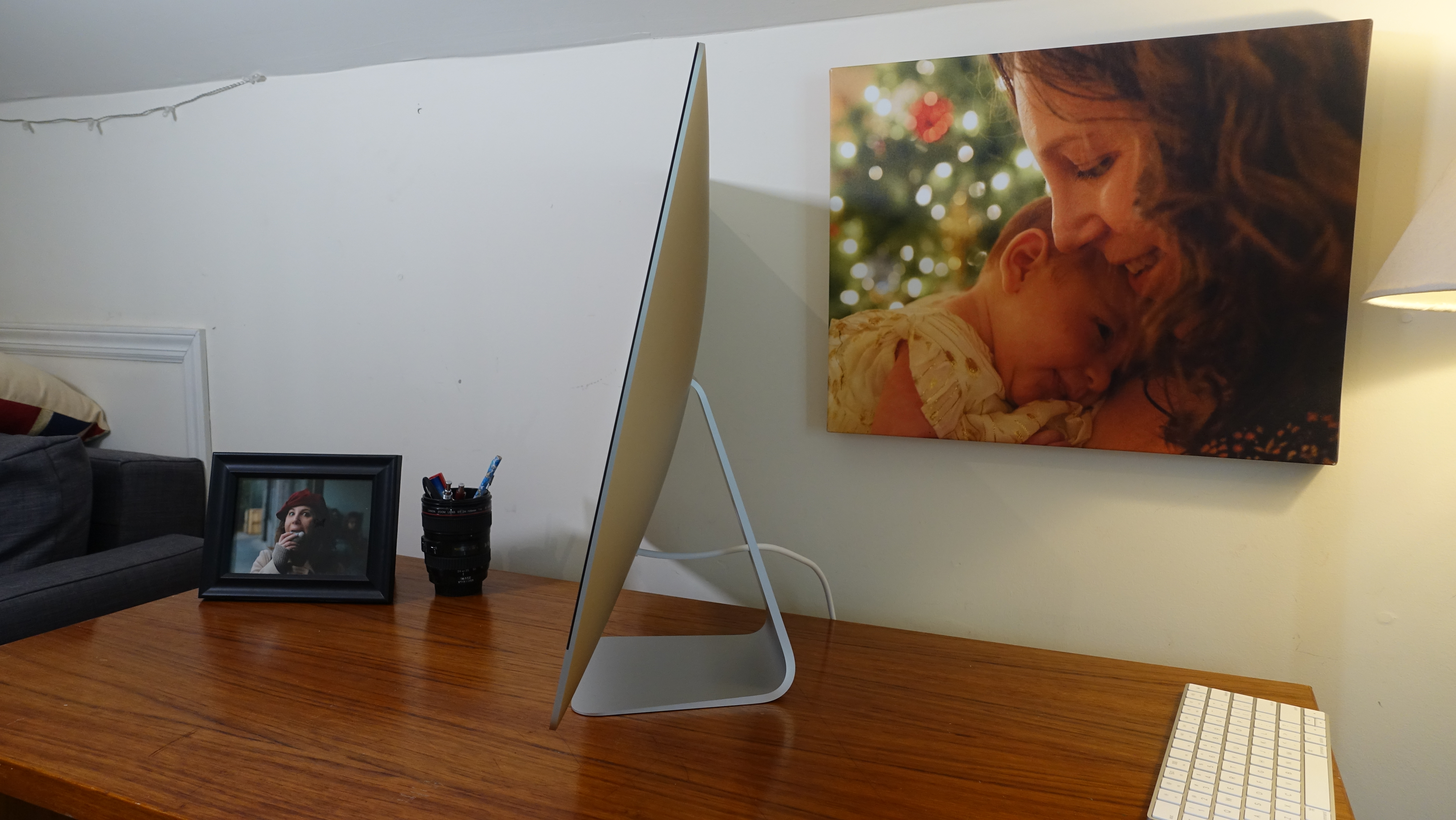
Nothing new here, which is both good and bad. The 2020 iMac has the same sleek profile as the past eight years, but it also has the same chunky bezels and thick aluminum chin beneath. With a display as nice as the iMac’s, it would be nice if Apple would show it off more with as little bezel as possible. While HP’s Pavilion and Dell’s Inspiron all-in-ones don’t have as clean a look as the iMac, they do their best to shrink the bezel on their PCs.
The 2020 iMac has the same sleek profile, but it also has the same chunky bezels and thick aluminum chin beneath.
The iMac also has the same stand, a thin slip of aluminum that curves down from the back of the display. While it lets you tilt the screen back, you can’t change its height. If you need the screen to be higher, you’ll have to prop it up on something.
The iMac still measures 25.6 inches wide by 20.3 inches tall, and including the stand, has a depth of 8 inches. It weighs 19.7 pounds.
Apple iMac 27-inch (2020): Ports
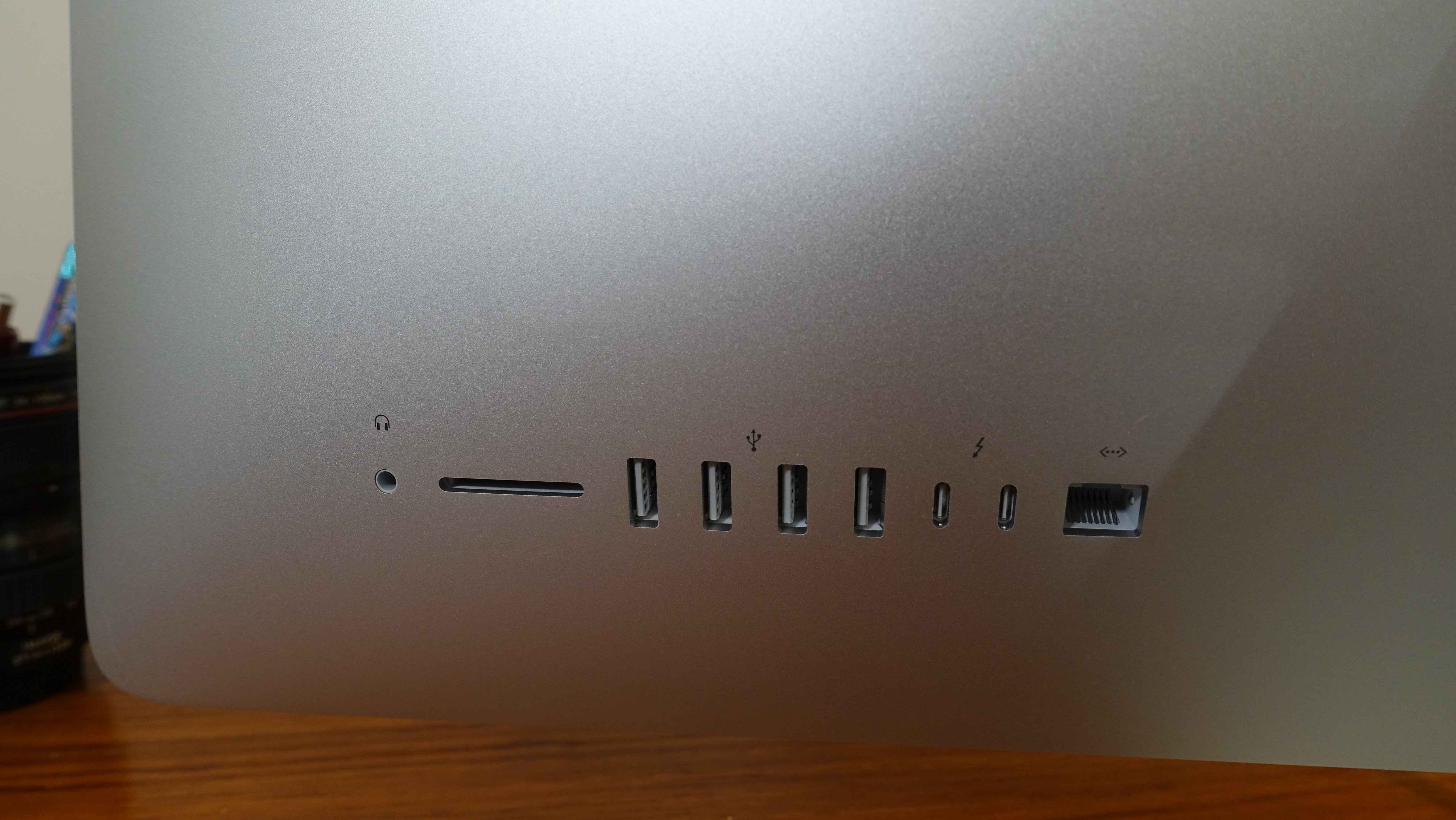
Nothing has changed since last year: The 2020 iMac sports two Thunderbolt 3 ports, four USB ports, an SDXC memory card reader, a Gigabit Ethernet port, and a headphone jack. As before, all the ports are on the rear of the system, which is great for its aesthetics, but a real pain when you want to slide in a memory card. Still, unlike Apple’s laptops, at least it has a memory card slot.
The iMac supports 802.11ac for Wi-Fi, and, in an upgrade from last year’s model, also supports Bluetooth 5.0.
Apple iMac 27-inch (2020): Display
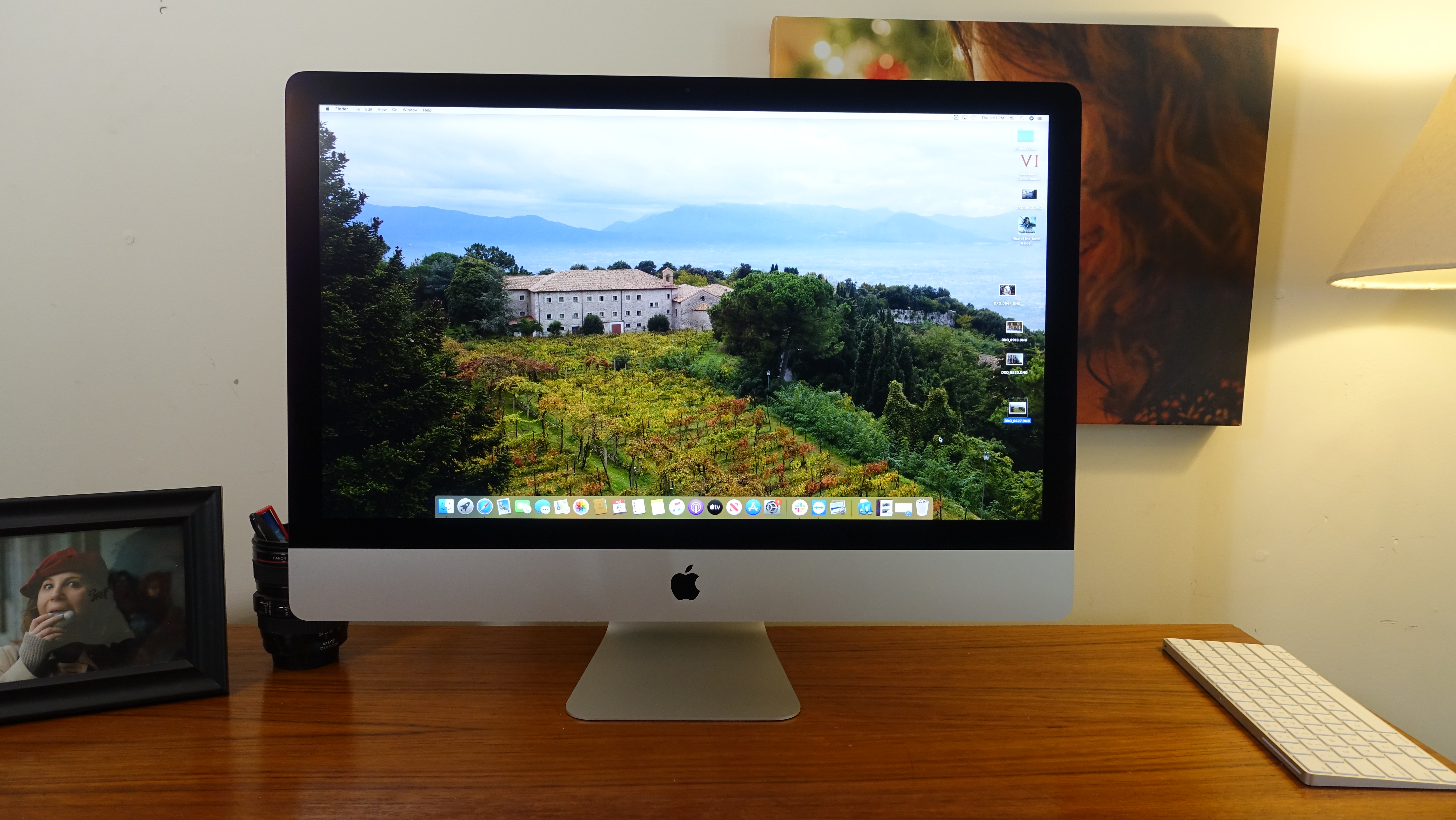
While the 2020 iMac has the same resolution and screen size as its predecessor (27 inches, 5120 x 2880 pixels and support for the P3 wide color space), it has a few new tricks to improve its viewability.
The biggest is the nano-texture option, which debuted on the Apple Pro Display XDR. This coating reduces glare, making it easier to see the screen when there’s a lot of ambient light.
For anyone who’s had to deal with screen glare, the nano-texture option will be worth the $500 investment. Remarkably, this option isn’t currently available for Apple’s iMac Pro, so video and photo professionals will be a bit torn on which model to get.
I held lights up right next to the screen, and aside from one small area closest to the light, the rest of the display remained free from reflections or glare. It also makes viewing angles excellent; you could easily fit a family of three or four around the screen to watch a movie without anyone complaining—about the image quality, at least.
I watched bits from a few movies, including Ford vs. Ferrari, 1917, and a number of trailers, and was impressed with not only the crispness, but the color fidelity and contrast of everything I saw.
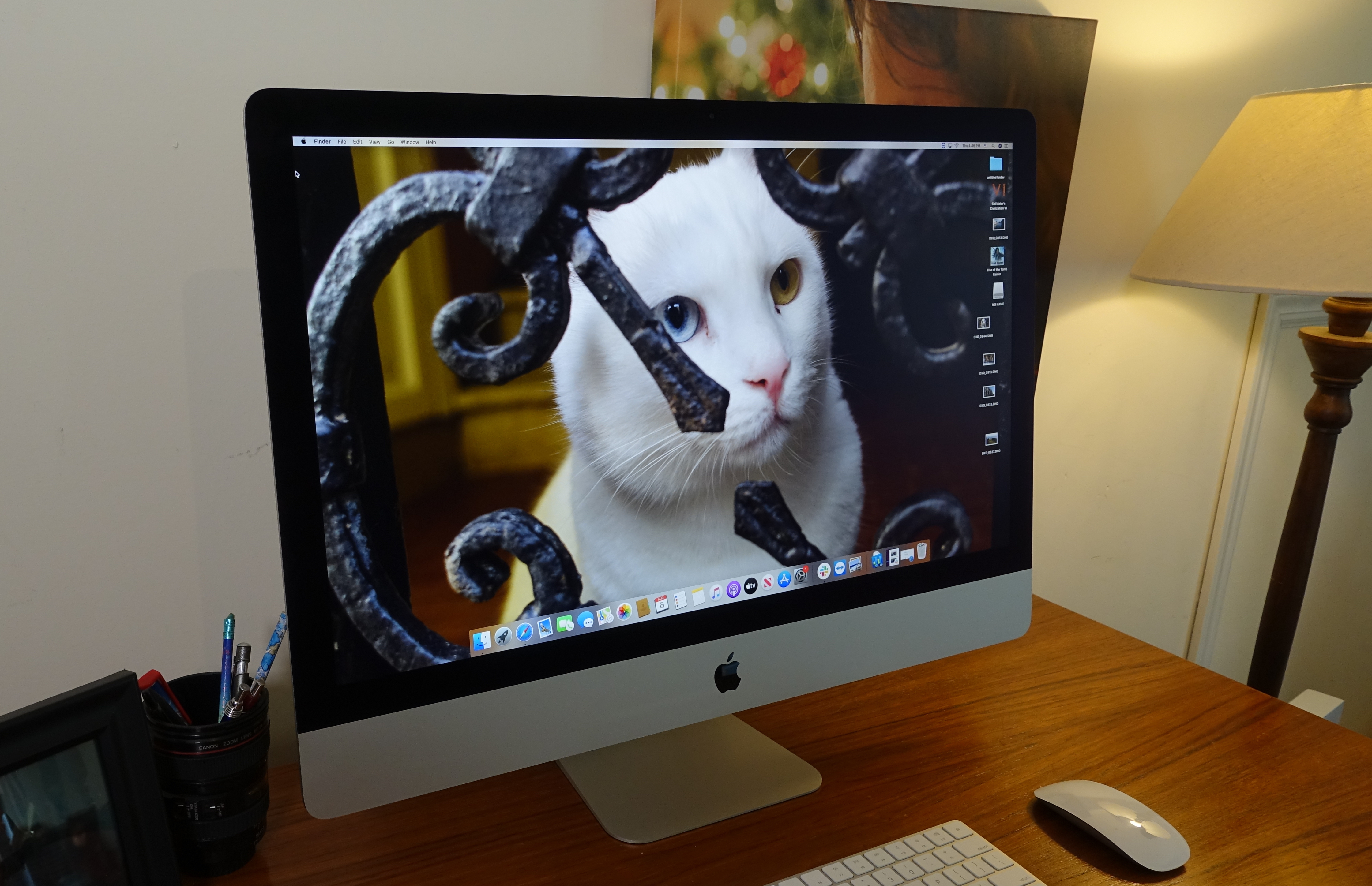
The other big feature on the iMac’s display is TrueTone support. Already available on the iPhone and MacBooks and iPads, TrueTone will change the display’s color temperature based on ambient light conditions. You can enable or disable this feature in the Control Panel, so those editing photos or video can get a more accurate depiction of what their images will look like.
My home office is lit by a few floor lamps and a little light from a window; activating TrueTone gave the screen a much warmer tone. When more or less light would stream in through the window, the tone would change noticeably, which can be a little distracting at times.
In a similar vein, you can also enable Night Shift, which will automatically adjust the screen colors to more warmer tones in the evening.
And no, it’s not a touchscreen.
Apple iMac 27-inch (2020): Audio
The 2020 iMac has the same speakers as its predecessor, but thanks to a new T2 chip, you can expect higher fidelity and deeper bass. I didn’t have last year’s iMac to compare, but I was impressed with what came out of the 2020 model.
I could really feel the deep grumble and whine of V8s and V12’s racing around LeMans in Ford vs. Ferrari. I was so immersed in the movie that my wife had to come and tell me to turn the volume down, for fear of waking our daughter.
Apple iMac 27-inch (2020): Webcam

Still can’t buy one of the best webcams? You won’t need an external camera with this iMac.. Boasting the same 1080p camera module as the iMac Pro, the iMac’s webcam also supports tone mapping, exposure control, and face detection. While it lacks Face ID, it can recognize your mug, and automatically apply adjustments so that you’re seen in the best light, so to speak.
Using Photo Booth I moved around the frame, and could definitely see the software at work; the whiteness of the background would shift from a reddish to a more white hue. However, it tinted my skin red, no matter where I sat. And, for a 1080p camera, I was a bit disappointed that details in my face weren’t sharper. Viewed at full size, my beard looked a bit mottled, and it was hard to pick out individual hairs.
I also used QuickTime to record myself; skin tones were much more true to life, and the background was also pretty accurate, too.
In addition, the iMac has three mics — two in the chin, and a third in the rear to help cancel out ambient noise. It works to an extent. My home office — which is also my attic — has a house fan that we use to keep cool. From where I was sitting, I recorded a noise level of about 52 decibels; on the recording, the iMac was able to minimize it pretty effectively.
Apple iMac 27-inch (2020): Performance
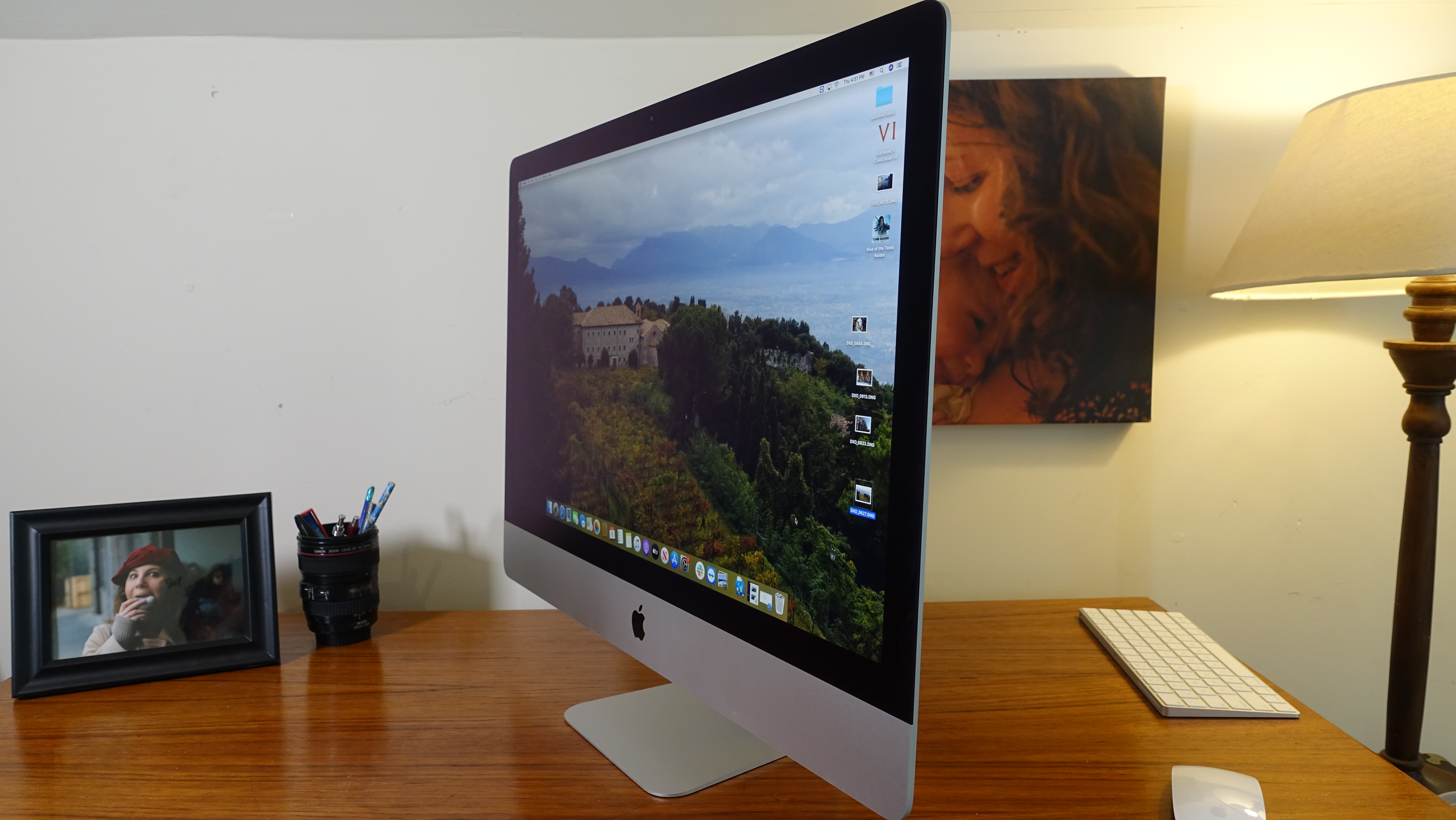
There seemed to be no task too big for the 3.6 GHz Intel Core i9-10910 CPU and 32GB of RAM in our review unit. Needless to say, you can open as many tabs in Chrome as you’d like and not have to worry about a performance hit.
To try and push the iMac to its limits, I opened 40 tabs in Chrome; the CPU hit was barely seven percent. I then fired up a few rounds of World of Tanks and blasted away at its highest settings without any impact. It was only when I used Handbrake to re-encode a video that the CPU was put to the test, but I still had plenty of power to spare.
Using the BlackMagic Disk Speed synthetic benchmark, the iMac’s 1TB SSD notched an average write speed of 2757 MBps and a read speed of 2467 MBps. That blows away not just last year’s iMac (1909MBps write/2,545 MBps read), but the iMac Pro (2,544MBps write), and left the Surface Studio 2 (815 MBps) and the Dell XPS 27 (1,208 MBps) in the dust.
On the Geekbench 5 CPU test, the iMac scored 1,300 on the single core test, and 9,843 on the multi-core test. To put that power in perspective, that multicore score beats out the 7,250 we got from our Core i9-powered MacBook Pro 16-inch.
Apple iMac 27-inch (2020): Graphics and gaming
Macs aren’t the go-to platform when it comes to gaming, but thanks to its Radeon Pro 5700 XT GPU and 16 GB of VRAM, the iMac is more than capable. On the Rise of the Tomb Raider benchmark (1080p, Very High settings), the iMac averaged 52.3 fps, edging past the Surface Studio 2’s score of 51 fps. On the Civilization IV benchmark, the iMac averaged 46.3 fps at 2560 x 1440, also a more than respectable score.
Apple is positioning the iMac as the desktop to get for amateur and semi-professionals, and our testing so far seems to back that up. We’re still running some other benchmarks, but the iMac was able to convert a 12-minute 4K video to 1080p in 5 minutes and 39 seconds using Handbrake. That’s notably faster than the 8 minutes we saw from the MacBook Pro 16-inch, which came powered with a Radeon 5500M GPU.
To really tax the system, I used Final Cut Pro X and applied the Aged Film filter to a two-hour and 30-minute 1080p video, and then timed how long it took to render. 33 minutes later, the rendering was complete. That’s an impressive render time, according to our head of video production.
Apple iMac 27-inch (2020): Keyboard and mouse
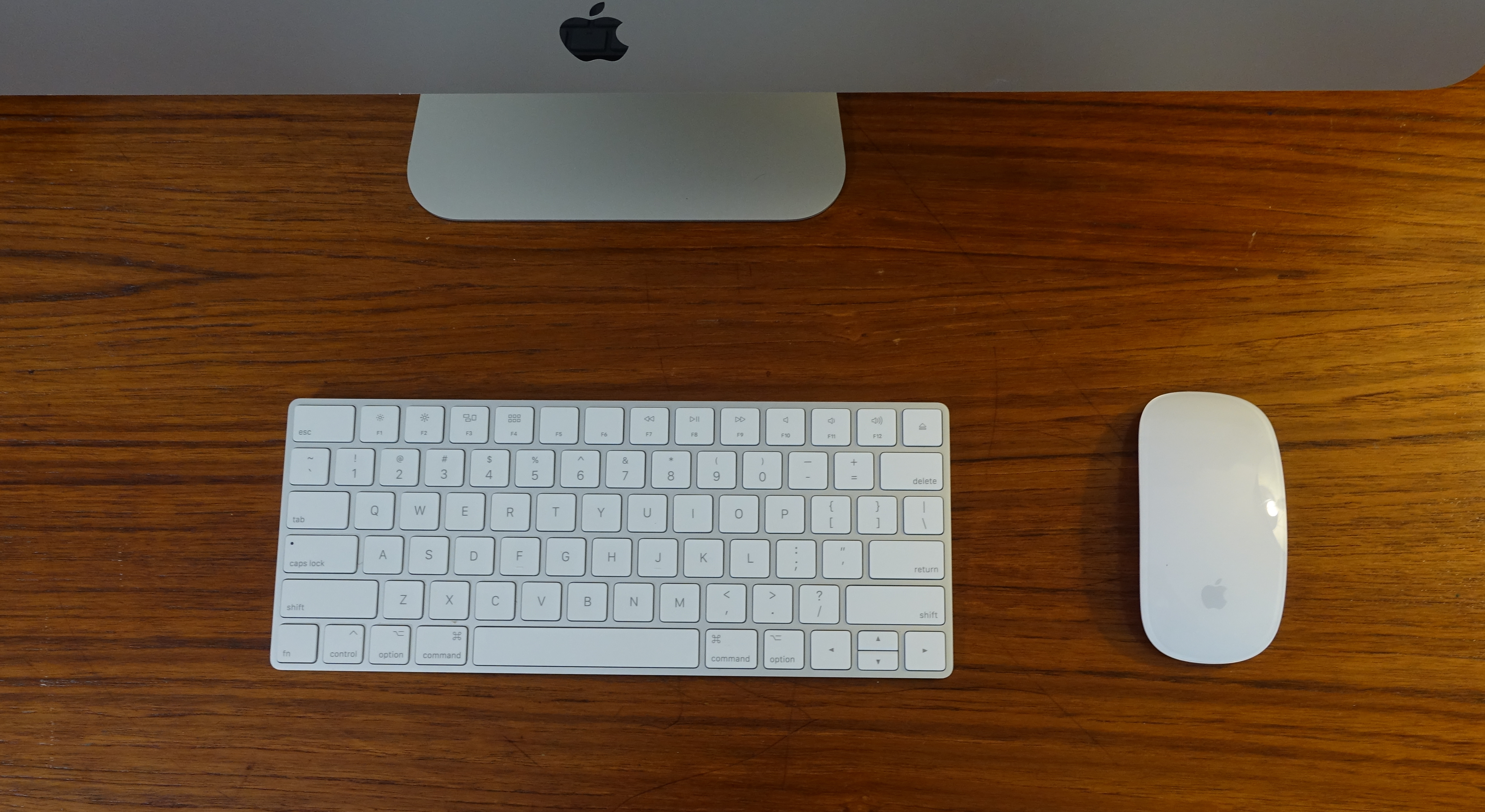
Maybe it’s because I’ve been using a Logitech G513 gaming keyboard and a Cooler Master MM830 gaming mouse for so long, but I found Apple’s minimalist keyboard and Magic Mouse to be very unsatisfying to use. They both look very sleek, but the low profile of the mouse, and the very slight travel of the keyboard made me long for my traditional keyboard and mouse quickly.
Still, after a short time, I was able to type fairly fast on the keyboard. Though it felt insubstantial in my hands, the mouse was responsive to my movements, as well as clicking and scrolling. And, they’re included as part of the package.
Apple iMac 27-inch (2020) review: Verdict
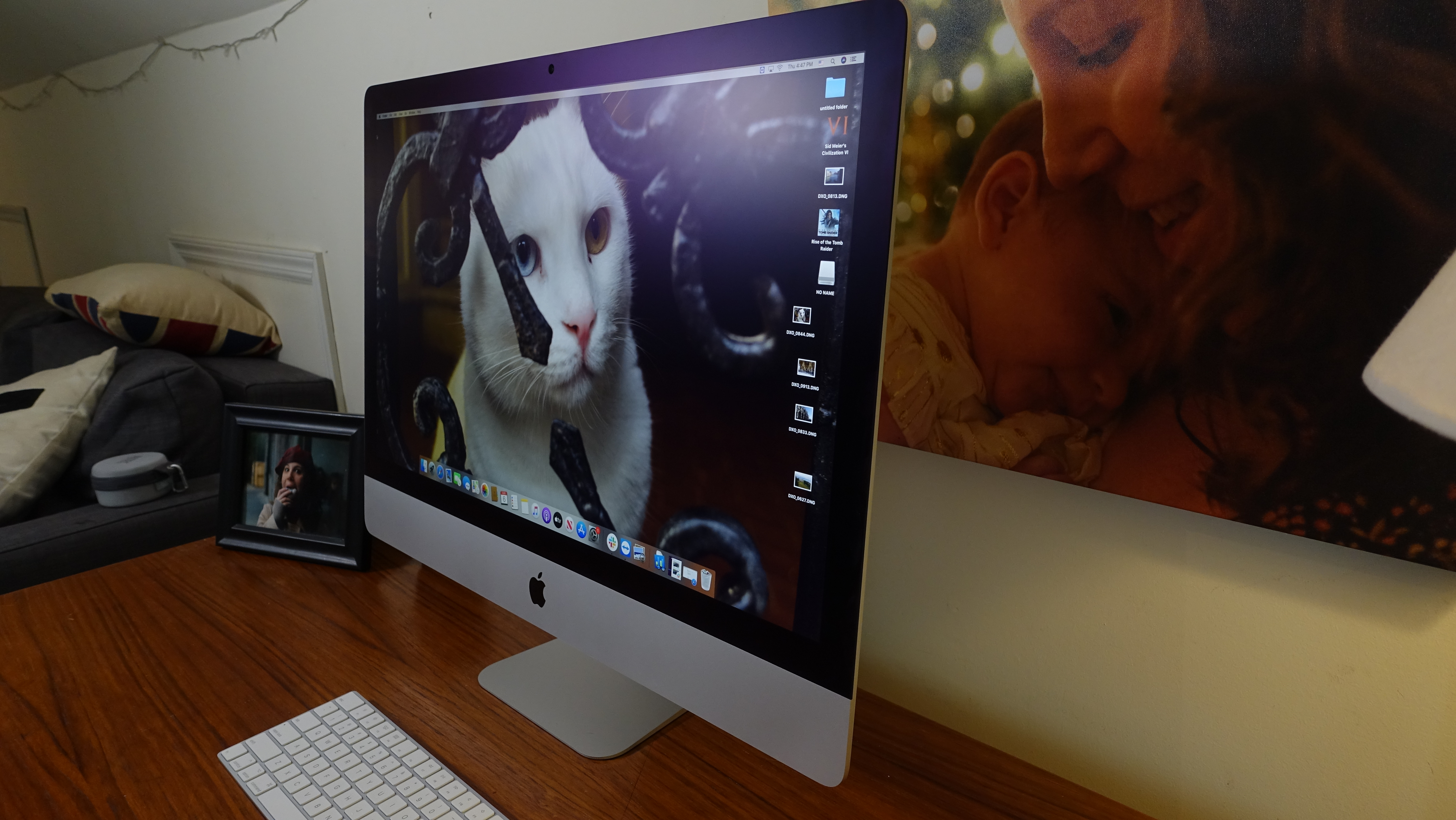
It’s more than likely that the 2020 iMac will be one of the last of Apple’s all-in-ones to run an Intel processor. If that’s the case, then Apple’s ARM chips have their work cut out for them. This machine — at least, the $4,500 model I tested — has some serious power, and a seriously gorgeous display. As with most Macs, it has a serious price to match, too.
The most comparable Windows model to our review unit is the Microsoft Surface Studio 2, which has a 28-inch 4500 x 3000-pixel display that can also display the P3 color gamut. The $4,199 configuration includes an Intel Core i7-7820HQ processor, 32GB of RAM, Nvidia GeForce GTX 1070 graphics, 8GB of video memory, and a 1TB SSD.
Closer to the iMac’s starting price is the HP Envy all-in-one (32-a1055) which costs $2,299, and has a 32-inch 4K display, 2.9GHz Intel Core i7-10700 processor, NVIDIA GeForce RTX 2070 , 16GB of RAM, a 512GB SSD and a 1TB, 7200rpm hard drive. Neither of those machines have the display resolution or quality of the iMac, though.
When the quarantine started, I was glad to have a nice big 27-inch Apple Cinema Display to which I could hook up my work MacBook Pro, so I wasn’t scrunched over a small screen in my home office. Given that we’ll be working from home at least through the end of 2020, investing in a capable desktop, as opposed to a laptop, seems like a smart idea. You get a lot more performance for the dollar, not to mention a lot more screen. So sit back and enjoy the iMac’s gorgeous 27-inch display.

Michael A. Prospero is the U.S. Editor-in-Chief for Tom’s Guide. He oversees all evergreen content and oversees the Homes, Smart Home, and Fitness/Wearables categories for the site. In his spare time, he also tests out the latest drones, electric scooters, and smart home gadgets, such as video doorbells. Before his tenure at Tom's Guide, he was the Reviews Editor for Laptop Magazine, a reporter at Fast Company, the Times of Trenton, and, many eons back, an intern at George magazine. He received his undergraduate degree from Boston College, where he worked on the campus newspaper The Heights, and then attended the Columbia University school of Journalism. When he’s not testing out the latest running watch, electric scooter, or skiing or training for a marathon, he’s probably using the latest sous vide machine, smoker, or pizza oven, to the delight — or chagrin — of his family.
-
NMI8080 Recent high-end (non-pro) iMacs have been hobbled by crappy cooling. so why dance around the elephant in the room? What was the fan noise like during all the gaming and benchmarks you did to write the article?Reply -
varase Yeah, I ordered a core-i9 and a Radeon 5700 XT - is the chassis able to cool the combo under load?Reply
-- Thanks, Verne -
Jagganatha For me the problem screams NO!Reply
I suppose you want to stay with a PCIe 3 logic board when read write speeds are already double what we see here in AMD motherboarded PCIe4 PCs? And Intel is soon to implement same, or even quadruple speeds with PCIe 5.0?
This is the Elephant in the Room for me, with there yet being nobody who has actually used one long enough to know. Read write speeds and the way CPU and GPU link to the motherboard is so much more sophisticated than what an iMac now has to offer, I put them in the same box as all those PC manufacturers passing off old kit at new kit prices in the hope customers do not know the difference......
That its performance outdoes the Mac Pro 7 and the iMac Pro in certain respects IF you shell out for the top BTO, may be a satisfying filip to help offset the debt involved in the total cost of ownership, but they are ALL running at half-speed, and you cant do anything to improve that, sorry.
I want an iMac that I control, not Apple. I want to fit ANY NVMe M.2. type SSD myself and be able to upgrade the graphics card and the processor even, and come Eternity when Apple have realised they can BigFoot it, I shall be able to do so.
There is nothing wrong with its look, and the thick black bezels stop you and your kids putting their greasy fingers on the screen. Why all you online pundits complain about the design that makes you always want to buy one, beats me!! Indeed I would go much further and go to a 30-40 inch square touchscreen. Why square? Because with squarescreens you do not have to rotate the screen to get a big enough vertical format image to look at and to edit, and Apples current Alu chinned screen is already getting back to square as it is. As a photographer the 16:9 formatted screen has limitations- except at 16:9. It means you get a much reduced image relative to what you want to be able to see.
So then all I have to do as designer is raise the base to be able to see at desk level properly without having to tilt the screen, and I do this by sticking all the components back in the base, where they used to be, remember? And where we can get at them. Have you ever stopped to realize the Fascistic Intent Apple have in preventing you doing more unless you pay Mac Pro prices, and even then....
By the way, the talk of pro microphones had me roaring with laughter, since they have to listen through solid walls of interference, electrical and physical, always have done!. -
mprospero Reply
The fan really kicked on during the Handbrake test, which was using just the CPU. I did hear the fan during the Final Cut Pro test, but it was much quieter.NMI8080 said:Recent high-end (non-pro) iMacs have been hobbled by crappy cooling. so why dance around the elephant in the room? What was the fan noise like during all the gaming and benchmarks you did to write the article? -
varase Reply
Well, to answer my own question I've had no thermal issues.varase said:Yeah, I ordered a core-i9 and a Radeon 5700 XT - is the chassis able to cool the combo under load?
My last primary was an iMac 5K purchased late in 2018 when my 2014 was going into the shop; this forced me to buy a 2017 - a year old model at this point - with a core-i7 4 core 8 thread, a Radeon Pro 580 8GB, and a 3 TB fusion drive. (I needed the capacity as the 2014 had a 3 TB fusion drive and in 2017 it was a 3 TB fusion drive or a 2 TB SSD which was uber expensive). The new model I really wanted arrived in early 2019 with a core-i9 and faster graphics.
The 2017's Kaby Lake processor was better than the 2014's Haswell processors and Radeon R9 M295X, but wasn't dramatically different.
This 2020 core-i9 10 core 20 thread 10910, Radeon Pro 5700 XT 16 GB with 40 compute units, 4 TB SSD, 10 gb ethernet, 8 GB -> 128 GB OWC memory machine is a beast.
My transcodes now take a third the time (just about exactly) and running my NNTP client fetching new headers, merging old headers, and grouping (about 72 million) messages now takes about 5 ½ minutes vs. almost an hour.
Also, now that my disk container is a single NVMe SSD I'm able to successfully use boot camp, whereas APFS on a 3 TB fusion drive was problematic and I really couldn't successfully create a non-problematic boot camp in Catalina (or I think Mojave).
I expect this to serve as my transition machine and will probably the the last and fastest consumer level Mac that's still boot campable, and I expect that any software which runs on Catalina will run on this machine while Apple silicon early adopters find and fix all of the transition problems for me.
Shadow of the Tomb Raider benchmarks on 1440p HDR with the highest settings on macOS at around 59 fps or so ... pretty much limited by the display refresh rate.
Also, found that transcoding a 1:58:58 1080p movie from MKV to an 8 bit HEVC mpeg4 took just around 14-18 minutes (depending on settings) at around 195-200 fps using Handbrake's H.265 (VideoToolBox), so it's able to use some seriously fast hardware transcode blocks somewhere (whether it's in the CPU, the T2 chip, or the GPU I have no idea).
In short, I'm very satisfied with this machine. -
NMI8080 Replyvarase said:My transcodes now take a third the time (just about exactly) and running my NNTP client fetching new headers, merging old headers, and grouping (about 72 million) messages now takes about 5 ½ minutes vs. almost an hour.
Shadow of the Tomb Raider benchmarks on 1440p HDR with the highest settings on macOS at around 59 fps or so ... pretty much limited by the display refresh rate.
Also, found that transcoding a 1:58:58 1080p movie from MKV to an 8 bit HEVC mpeg4 took just around 14-18 minutes (depending on settings) at around 195-200 fps using Handbrake's H.265 (VideoToolBox), so it's able to use some seriously fast hardware transcode blocks somewhere (whether it's in the CPU, the T2 chip, or the GPU I have no idea).
It's great that you're not seeing any throttling in these tests and you're getting full value for the hardware. How is the noise level during transcodes, gaming, etc.? -
varase Well, my transcode using H.265 (Video Toolbox) encoder (vt_h265 in HandBrake parlance) uses only around 25% of the CPU and takes 14-18 minutes, but flipping to HandBrake's x265 encoder put all the load on the CPU at which point the fan spun up nicely, CPU peaked, and the encode took an hour and a half. IIRC, the x264 encoder would take 15-20 minutes for the same transcode, but when I discovered the vt_h265 encoder I switched to HEVC for the smaller size and more rapid transcode.Reply
I have TG Pro installed, but it simply pushes the fan to 100% more quickly, and at 100% the fan is noticeable but less so than my 16" MacBook Pro. It's got a deeper tone due to a larger diameter fan and sounds less like a gas station air pump with the release valve depressed.
I normally compute with a pair of Koss PortaPros on (in case I need to make a call or a call comes in on my iPhone) so I hardly notice the fan, and truth to tell I haven't even tried out the new variable EQ in the built-in speakers yet.
Nice things about the form factor staying the same is that I was able to take my 8 GB RAM configuration up to 128 GB using OWC RAM in less than a minute, and since everything is the same as my 2017 installing the 2020 5K was simply putting the 2017 into target disk mode, booting the 2020 and putting a Thunderbolt 3 cable between the two machines and letting Migration Assistant do it's thing. Then I put the 2020 where the 2017 used to sit and simply plugged in all the cables to connect all my peripherals. While I was at it I replaced a malfunctioning 7 port USB 3 hub with a new 10 port model which offers 5v 2.1A charging on every port (but no weird high voltage Qualcomm charging which can burn out the numerous peripherals that that charge on USB 3). Easy peasy.
I did have a major kerfuffle putting Boot Camp on though - I reformatted and restored from a Carbon Copy Cloner backup because of a glitch caused (I think) but not having boot security turned off.
In case you're interested, here's the glitch: once Boot Camp was installed, many times Disk Utility wouldn't successfully initialize, and my newly purchased Parallels 16 couldn't see the Boot Camp partition. When I found it was impossible to cleanly shut down the Mac I reformatted, reinstalled Catalina, and Migration Assistant restored from a CCC backup and the problem went away.
Trouble is, one of the reasons I got such a heavy configuration was my intention to have Boot Camp Win 10 so I could play all those AAA titles I had missed out on, and after everything was boringly working fine I tried again - with the same results.
I rebooted into Internet Recovery to check my disks and found the boot security settings, and first tried the trust Apple recognized OSes with the same result. I then set it to the allow me to boot anything setting and then everything started working fine: Parallels saw the Boot Camp disk, Disk Utility would initialize properly, and macOS would shut down cleanly.
Weird. I just installed the latest Windows 10 Pro 2004 on a 500 GB partition - you'd think that would be a recognized OS.
Anyway, after getting over that hurdle everything is going swimmingly. I've installed Steam and the big Halo bundle (Master Chief Collection?) and am waiting for my Xbox controller to arrive.
On the macOS side, Tomb Raider, Rise of the Tomb Raider, and Shadow of the Tomb Raider all seem to benchmark at around 59-60 FPS at high settings at 1440p HDR - HDR being a setting in SotTR - which enables the HDR stuff, but the display is really an EDR display since it technically can't hit the required 1000 NIT brightness (hats off to the Pro Display XDR).
So yeah, I'm very happy with this machine, and expect to use it for a few years. Who knows - maybe it'll even retain good resale value as the hottest consumer Mac ever with Boot Camp capability.
Edit: I didn't say there's no thermal throttling - I don't know how to objectively evaluate that. With all CPUs running hot, the primary cores are at around 100% and the secondary SMT cores appear to be around 30% according to the little iStat Menus histograms. Eventually under sustained load they lower to around 60% of speed, but at no time did I notice clocks dropping below the base clock of 3.6ghz.
The 10900K is the overclockable version and has a TDP of 125w but can use over 300w if adequately cooled (and they shaved the top of the chip to give you the surface area for that). This 10910 supposedly has a TDP of 95w but seems to be limited to 150w or so under load.
The iMac 5K is not cooled like a gaming PC so I have no idea what this chip could do with liquid metal heat transfer and a liquid cooling loop. It's a Mac which can game, not a Mac designed to game. -
varase Reply
You know, it's interesting to see those who push home-built component monstrosities because they never tell you the whole story - about how much time they spend debugging bleeding edge motherboards and PCI peripherals and what they had to do to get everything working together.Jagganatha said:For me the problem screams NO!
I suppose you want to stay with a PCIe 3 logic board when read write speeds are already double what we see here in AMD motherboarded PCIe4 PCs? And Intel is soon to implement same, or even quadruple speeds with PCIe 5.0?
This is the Elephant in the Room for me, with there yet being nobody who has actually used one long enough to know. Read write speeds and the way CPU and GPU link to the motherboard is so much more sophisticated than what an iMac now has to offer, I put them in the same box as all those PC manufacturers passing off old kit at new kit prices in the hope customers do not know the difference......
That its performance outdoes the Mac Pro 7 and the iMac Pro in certain respects IF you shell out for the top BTO, may be a satisfying filip to help offset the debt involved in the total cost of ownership, but they are ALL running at half-speed, and you cant do anything to improve that, sorry.
I want an iMac that I control, not Apple. I want to fit ANY NVMe M.2. type SSD myself and be able to upgrade the graphics card and the processor even, and come Eternity when Apple have realised they can BigFoot it, I shall be able to do so.
There is nothing wrong with its look, and the thick black bezels stop you and your kids putting their greasy fingers on the screen. Why all you online pundits complain about the design that makes you always want to buy one, beats me!! Indeed I would go much further and go to a 30-40 inch square touchscreen. Why square? Because with squarescreens you do not have to rotate the screen to get a big enough vertical format image to look at and to edit, and Apples current Alu chinned screen is already getting back to square as it is. As a photographer the 16:9 formatted screen has limitations- except at 16:9. It means you get a much reduced image relative to what you want to be able to see.
So then all I have to do as designer is raise the base to be able to see at desk level properly without having to tilt the screen, and I do this by sticking all the components back in the base, where they used to be, remember? And where we can get at them. Have you ever stopped to realize the Fascistic Intent Apple have in preventing you doing more unless you pay Mac Pro prices, and even then....
By the way, the talk of pro microphones had me roaring with laughter, since they have to listen through solid walls of interference, electrical and physical, always have done!.
The real elephant in the room is what happens when things go wrong, and the application developer, the OS developer, and half a dozen hardware vendors are all pointing fingers at one another.
Sure you can upgrade and balance bits and pieces of your system, and you can hobble them together and get some kind of workflow going, but everything doesn't work right out-of-the-box and the tuning and support factors mean you're spending a lot more time debugging and trying to get things like colors balanced and true - let alone colors balanced between screens and say print devices.
And another thing: once you add in the cost of a high density display which can match the 5K iMac's 500 NIT EDR panel all your savings go out the window - if you can find one.
You mention TCO - but I don't think you know what you're talking about, or you're placing no value on your own time. TCO on an iMac is very good, because when you're ready to sell you're going to get substantially more back on your original investment than you would with a monster system with no single source of support. iMacs are actually very competitive on price (provided you don't buy Apple RAM).
If you buy 4 or 8 TB SSDs, they come on daughter cards so if you have a future storage problem or upgrade needs, there may be OEM vendors who offer replacements - and these PCIe SSDs are seriously fast.
Unless you're running a render farm - and that's not what these machines are designed to do - they have plenty of power for the intended purpose. and you can get better 24x7 domestic support from people who speak english you can understand, and domestic repair depots where you can get fixed price repairs if things go really south.


